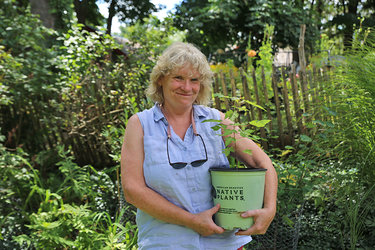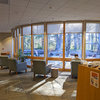Laura Barry plants hope along with native trees
GUILDERLAND — Laura Barry is like a modern-day Johnny Appleseed.
Except, instead of planting apple trees, which originated in Asia, she is planting native trees.
“I planted about 15 trees this year, little saplings and things all over the place secretly,” she says, improving open land.
Barry explains in this week’s Enterprise podcast that she was removing a friend’s Oriental bittersweet, which kills trees “because it strangles them,” when she discovered the maple saplings.
“I’m growing them so I can go get more next year …,” she said. “Oh, it's fun!”
While nurseryman John Chapman, whom legend calls Johnny Appleseed, brought fruit trees that European settlers in the New World craved, Barry is replenishing native plants — the only native apple is the crab apple — in Guilderland that will help threatened native pollinators, native insects, and native birds and animals.
“I come from farm people in Connecticut so I always was around nature,” Barry says of her family. “Our idea of a fun time would be to look at a dogwood tree and see what was going wrong with it.”
Her brother, who lives in North Carolina, became a tree farmer while she became a teacher. Barry retired after teaching physical education to kids for 37 years.
But she is still teaching — as a master gardener. Barry, who describes herself as a “continual learner,” completed six months of training and a year-long apprenticeship, “equal to college courses,” to become a volunteer in the program, answering hotlie questions and helping maintain the extension’s gardens on Martin Road in New Scotland, across from Voorheesville’s high school.
She mostly works in the vegetable garden, “doing experimental crops and seeing how they work in all the different counties in the state. What are the outcomes? And we document it and take pictures and harvest it and describe what we eat.”
The varied Cronell gardens have blossoms throughout the growing season, which is important for pollinators. “So you want early bloomers, mid-season bloomers, fall bloomers,” said Barry. “Like now, you really want asters and goldenrod, which are so important.”
The public is welcome to tour and learn from the gardens any time, free of charge.
Like Johnny Appleseed, Barry is not just sticking to her own yard, in McKownville, but has almost a missionary zeal in spreading the word on the importance of native plants.
As a member of Guilderland’s environmental conservation committee, she walked properties across town slated for development to identify the plants. And then, she and others in her historic neighborhood on the edge of Guilderland next to the city of Albany, walked the tree-lined streets and discovered, “Just in this little hamlet, over 100 street trees are missing.”
“I could see there is no plan for replacement. There’s no plan for care,” said Barry. “We’ve been kind of on borrowed time throughout the town.”
So she became part of a group, working with the town’s planner, supervisor, park director, and others, to come up with a bill that would create a forestry committee to develop a forestry plan for Guilderland.
Properties slated for development will be part of the plan as well as the town-owned parks and land running alongside streets. If the law passes, private-property owners will continue to be able to do as they wish with yards but Barry hopes they will learn about and become interested in planting native trees and plants.
She described manicured lawns raised with chemical fertilizers as toxic. “Shrink your lawn,” Barry advises. “Try to make yourself have a smaller yard. Grass is … like a dead zone — nothing native lives unless clover is sprouting or you allow violets to grow in it.
“Otherwise, all it is, is like almost a toxic waste site because you’re dumping all kinds of chemicals,” says Barry, noting that lawns also use a lot of water while native plants don’t.
Instead of a lawn, she recommends “an area on the edges of your property layered with native flowers, shrubbery, lower trees” — and names several favorites.
Empty land starts naturally growing a “pioneer forest,” said Barry with native grasses and native flowering plants like milkweed. “They add nutrients to the ground” so then pioneer trees like birch or alder or cottonwood can grow there.
Those short-lived trees then further enrich the soil so bigger longer-lasting trees like maples and oaks can grow there, she said.
Barry is referring to native trees like a sugar maple, not an invasive tree like the Norway maple that had been planted in her own yard. “They create no nutrients,” she said. “They actually alter the nutrients in the soil so the native species can’t even grow.”
Also, an invasive, like a Norway maple, won’t support native pollinators. “So, if you don't have caterpillars, you don’t have birds,” said Barry. She notes, “One clutch of chickadees needs 6,000 to 8,000 caterpillars when they are growing in the nest … And, you know, the bird population has gone down 50 percent.”
She also cites this “cool” fact: It takes four trees to replace the oxygen that a single human being uses. “The trees take in the carbon dioxide and put out oxygen,” said Barry. “So that’s why you feel better in the forest, because there’s more oxygen.”
Most of the Earth’s oxygen comes from plankton in the oceans, she said. “But trees add to it and, more importantly, they sequester in their trunks and roots all the carbon that we’re blowing into the atmosphere.”
While a gingko tree is beautiful, with gorgeous leaves, says Barry, “nothing, nothing lives on a gingko.”
Barry urges others to do as she has and gradually add native plants to their landscape. She has planted chokeberry and birch because there were none in her neighborhood. She has removed the invasive burning bush and barberry that were there when she bought her house.
The McKownville Improvement Association has posted a list on its website of native trees and plants, which links to information from Cornell. She also recommends the WildOnes website, which has a Capital Region chapter in New York, and the online instruction by ecologist Douglas W. Tallamy.
“Last summer,” said Barry, “I kind of hit a low point in thinking like, man, with the climate change and people’s attitudes, this isn’t good. We’re not going to make it … time is running out.”
But then she read a piece by a scientist “who turned it around and she said, ‘Oh, time isn’t up. If we could just plant more trees because the trees sequester the carbon and it will buy us time.’”
Barry said, “So the less we take down trees in the town … and maintain what we have and plant more, then there’s hope.”
She concluded, “It’s up to us in our own yards to care and do something. And being a member of the town, as a citizen, I wanted to help do that. …. It’s so much better to do something than just complain about it.”



